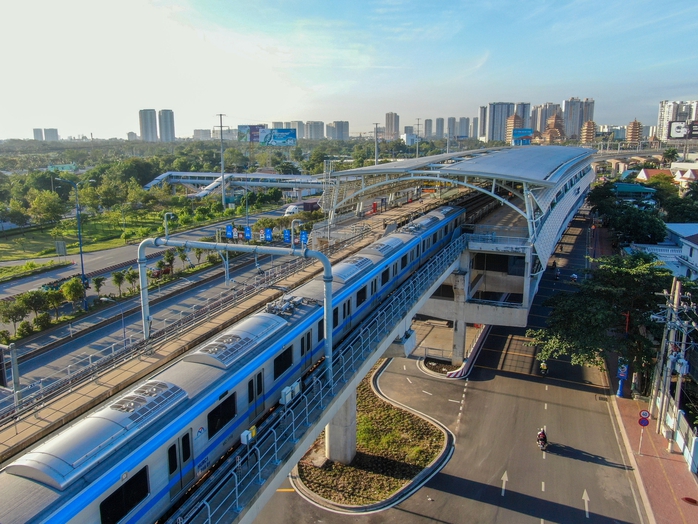The Ho Chi Minh City People's Committee has just issued a document to relevant units regarding the implementation of Notification No. 01/2025 from the Steering Committee for the Development of Ho Chi Minh City's urban railway network system.
Accordingly, the Chairman of the Ho Chi Minh City People's Committee assigned the Department of Construction, Department of Finance, Department of Agriculture and Environment, Department of Home Affairs, Urban Railway Management Board, and Urban Railway Company No. 1 to thoroughly and seriously implement the conclusions of the Steering Committee and the directives of the Ho Chi Minh City People's Committee as outlined in Notification No. 529/2025.
Units are required to promptly report and propose solutions to the Ho Chi Minh City People's Committee for consideration and resolution if they encounter difficulties or issues beyond their authority.

The development of metro systems needs to be placed in the context of expanding administrative boundaries. Photo: Hoang Trieu
The Department of Construction is tasked with urgently reviewing the overall urban railway network planning based on a new model and vision, aligned with the context of the city's administrative boundary expansion (the merger of Binh Duong, Ba Ria - Vung Tau and Ho Chi Minh City).
Based on this, the department will propose adjustments to the City Master plan for the 2021–2030 period, with a vision to 2050; the general city plan until 2040, with a vision to 2060; and related technical infrastructure specialized plans (including underground space planning).
Efforts will be made to significantly shorten the time required for procedures and investment approvals for urban railway projects, ensuring effective integration with other transportation modes (road, waterway, bus, etc.).
A comprehensive strategy, program, and implementation plan with a clear roadmap will be developed, flexibly applying special mechanisms and closely coordinating with relevant parties to ensure a balance of interests among the State, investors, and society.
The Department of Finance is tasked with urgently developing a plan and proposal for mobilizing investment capital for the urban railway network in line with the Urban Railway Development Proposal outlined in Conclusion No. 49 of the Politburo, ensuring compliance with the requirements and progress of the approved urban railway routes.
The department will study and propose a dedicated investment fund model for urban railway development, calculating the maximum mobilization of resources and diversifying funding sources, including Public-Private Partnerships (PPP), non-state budget capital, and other legal funding sources.
The Department of Agriculture and Environment is tasked with urgently researching and proposing an organizational model with sufficient authority and legitimacy to implement compensation, support, and resettlement for urban railway projects in the context of the city transitioning to a two-tier local government system (without district-level administration).
A clear operational mechanism and task assignment will be established following the "6 clear" principle: clear personnel, clear tasks, clear timelines, clear responsibilities, clear deliverables, and clear authority. The goal is to complete the handover of cleared land for project construction by 2028 at the latest.
The process will be transparent and public, with reasonable compensation and resettlement policies, alongside additional support policies to ensure the rights and benefits of affected residents, fostering public consensus.
The Urban Railway Management Board is tasked with accelerating the preparation of urban railway projects, including selecting capable and experienced domestic and international consultants, strengthening the Expert Group, and consulting on the implementation of Ho Chi Minh City's urban railway system in line with Conclusion No. 49 and Resolution No. 188.
Based on the development plan, Ho Chi Minh City will have 12 urban railway lines with a total length of approximately 510 km.
Under Resolution No. 188 of the National Assembly on piloting specific mechanisms and policies to develop the urban railway network, the city is expediting procedures to simultaneously invest in 7 lines, totaling 355 km, expected to be completed within the next 10 years. Additionally, two urban railway lines connecting central Ho Chi Minh City to Can Gio and Thu Thiem to Long Thanh are being promoted for private investment.
Meanwhile, Binh Duong is planned to have 12 lines with a total length of approximately 305 km, and Ba Ria – Vung Tau will have 3 lines spanning 125 km.
Thus, after the administrative boundary expansion, the new Ho Chi Minh City will have nearly 1,000 km of urban railway, excluding national railway lines being implemented by the central government or those to be adjusted for local implementation.





Bạn không thể gửi bình luận liên tục. Xin hãy đợi
60 giây nữa.